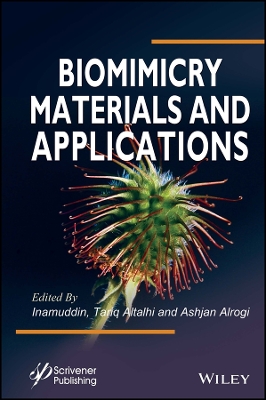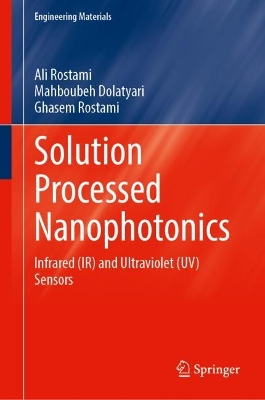Biomimicry Materials and Applications
 portes grátis
portes grátis
Biomimicry Materials and Applications
Altalhi, Tariq; Alrogi, Ashjan; Inamuddin
John Wiley & Sons Inc
07/2024
256
Dura
Inglês
9781394166213
Pré-lançamento - envio 15 a 20 dias após a sua edição
666
Descrição não disponível.
Preface xi
1 Biomimetic Optics 1
Priya Karmakar, Kripasindhu Karmakar, Sk. Mehebub Rahaman, Sandip Kundu, Subhendu Dhibar, Ujjwal Mandal and Bidyut Saha
1.1 Introduction 1
1.2 What is Biomimicry? 4
1.3 Step-by-Step Approach for Designing Biomimetic Optical Materials From Bioorganisms 6
1.3.1 Optical Structure Analysis in Biology 6
1.3.2 The Analysis of Optical Characteristics in Biological Materials 8
1.3.3 Optical Biomimetic Materials Fabrication Strategies 9
1.4 Biological Visual Systems--Animal and Human 10
1.4.1 Simple Eyes 10
1.4.2 Compound Eyes 12
1.4.2.1 Appositional Compound Eyes 12
1.4.2.2 Superpositional Compound Eyes 13
1.5. The Eye's Optical and Neural Components 15
1.5.1 Cornea 15
1.5.2 Pupils 16
1.5.3 Lens 17
1.5.4 Retina 19
1.6 Application of Biomimetic Optics 20
1.6.1 Hybrid Optical Components are Meant to Resemble the Optical System of the Eye 20
1.6.2 Microlens With a Dual-Facet Design 21
1.6.3 Fiber Optics in Nature 23
1.6.4 Bioinspired Optical Device 24
1.6.4.1 Tunable Lenses Inspired by Nature 24
1.6.4.2 X-Ray Telescope 24
1.6.4.3 Bioinspired Sensors 25
1.7 Conclusion 26
2 Mimicry at the Material-Cell Interface 35
Rajiv Kumar and Neelam Chhillar
2.1 Cell and Material Interfaces 36
2.2 Host-Microbe Interactions and Interface Mimicry 38
2.3 Alterations in Characteristics and Mimicking of Extracellular Matrix 41
2.4 Mimicry, Manipulations, and Cell Behavior 43
2.5 Single-Cell Transcriptomics and Involution Mimicry 44
2.6 Molecular Mimicry and Disturbed Immune Surveillance 46
2.7 Surface Chemistry, and Cell-Material Interface 48
2.8 Cell Biology and Surface Topography 50
2.9 3D Extracellular Matrix Mimics and Materials Chemistry 51
2.10 Microbe Interactions and Interface Mimicry 53
2.11 Hijacking of the Host Interactome, and Imperfect Mimicry 56
2.12 Vasculogenic Mimicry and Tumor Angiogenesis 65
3 Bacteriocins of Lactic Acid Bacteria as a Potential Antimicrobial Peptide 83
Ajay Kumar, Rohit Ruhal and Rashmi Kataria
3.1 Introduction 83
3.2 Bacteriocins 85
3.3 Lactic Acid Bacteria 86
3.4 Classification of LAB Bacteriocins 87
3.4.1 Class I Bacteriocins or Lantibiotics 87
3.4.1.1 Class Ia 87
3.4.1.2 Class Ib 88
3.4.1.3 Class Ic or Antibiotics 88
3.4.1.4 Class Id 88
3.4.1.5 Class Ie 88
3.4.1.6 Class If 89
3.4.2 Class II Bacteriocins 89
3.4.3 Class III Bacteriocins 89
3.5 Mechanisms of LAB Bacteriocins to Inactivate Microbial Growth 89
3.5.1 Action on Cell Wall Synthesis 90
3.5.1.1 Pore Formation 90
3.5.1.2 Inhibition of Peptidoglycan Synthesis 91
3.5.2 Obstruction in Replication and Transcription 92
3.5.3 Inhibition in Protein Synthesis 92
3.5.4 Disruption of Membrane Structure 92
3.5.5 Disruption in Septum Formation 93
3.6 Antimicrobial Properties of LAB Bacteriocins 93
3.6.1 Antiviral Activity 93
3.6.2 Antibacterial Properties 94
3.6.3 Antifungal Activity 94
3.7 Applications 95
3.7.1 Bacteriocins in Packaging Film 95
3.7.2 Potential Use as Biopreservatives 95
3.7.3 Bacteriocins as Antibiofilm 95
3.7.4 Applications in Foods Industries 96
3.8 Conclusion 96
4 A Review on Emergence of a Nature-Inspired Polymer-Polydopamine in Biomedicine 105
Lakshmi Nidhi Rao, Arun M. Isloor, Aditya Shetty and Pallavi K.C.
4.1 Introduction 106
4.2 Structure of PDA 107
4.3 Polydopamine as a Biomedical Material 108
4.4 Polydopamine as a Biomedical Adhesive 109
4.5 Availability of Polydopamine and its Biomedical Applications 110
4.6 Polydopamine Coatings of Nanomaterials 111
4.7 Polydopamine-Based Capsules 112
4.8 Polydopamine Nanoparticles and Nanocomposites 112
4.9 Polydopamine Properties 113
4.9.1 Cell Adhesion 113
4.9.2 Mineralization and Bone Regeneration 114
4.9.3 Blood Compatibility 117
4.9.4 Antimicrobial Effect 117
4.10 Dental Applications 118
4.11 Dental Adhesives 118
4.11.1 Tooth Mineralization 119
4.12 Conclusions 120
5 Application of Electroactive Polymer Actuator: A Brief Review 127
Dillip Kumar Biswal
5.1 Introduction 128
5.2 Chronological Summary of the Evolution of EAP Actuator 128
5.3 Electroactive Polymer Actuators Groups 129
5.3.1 Ionic Electroactive Polymers 130
5.3.2 Electronic Electroactive Polymers 131
5.4 Application of Electroactive Polymer Actuators 132
5.4.1 Soft Robotic Actuator Applications 133
5.4.2 Underwater Applications 133
5.4.3 Aerospace Applications 134
5.4.4 Energy Harvesting Applications 135
5.4.5 Healthcare and Biomedical Applications 135
5.4.6 Shape Memory Polymer Applications 136
5.4.7 Smart Window Applications 137
5.4.8 Wearable Electronics Applications 137
5.5 Conclusion 138
6 Bioinspired Hydrogels Through 3D Bioprinting 147
Farnaz Niknam, Vahid Rahmanian, Seyyed Mojtaba Mousavi, Seyyed Alireza Hashemi, Aziz Babapoor and Chin Wei Lai
6.1 Introduction 148
6.2 Bioinspiration 150
6.3 3D Bioprinting 151
6.3.1 Inkjet Bioprinting 151
6.3.2 Extrusion Printing 154
6.4 Hydrogels as Inks for 3D Bioprinting 156
6.5 Polymers Used for Bioinspired Hydrogels 157
6.5.1 Alginate 157
6.5.2 Cellulose 159
6.5.3 Chitosan 161
6.5.4 Fibrin 161
6.5.5 Silk 163
6.6 Conclusion 164
7 Electroactive Polymer Actuator-Based Refreshable Braille Displays 169
Pooja Mohapatra, Lipsa Shubhadarshinee and Aruna Kumar Barick
7.1 Introduction 170
7.2 Refreshable Braille Display 172
7.3 Electroactive Polymers 173
7.4 EAP-Based Braille Actuator 175
7.5 Conclusions 177
8 Materials Biomimicked From Natural Ones 179
Carlo Santulli
8.1 Introduction 179
8.2 Damage-Tolerant Ceramics 182
8.2.1 General Considerations 182
8.2.2 Nacre 183
8.2.3 Tooth Enamel 185
8.3 Protein-Based Materials With Tailored Properties 185
8.3.1 General Considerations 185
8.3.2 Dragline Silk 186
8.3.3 Fish Scales 187
8.4 Polymers Fit for Easy Junction/Self-Cleaning 188
8.4.1 General Considerations 188
8.4.2 Gecko for No-Glue Adhesion 189
8.4.3 Blue Mussel for Development of Specific Adhesives 190
8.4.4 Shark Skin for Functional Surfaces 190
8.5 Recent Prototype Developments on Materials Biomimicked from Natural Ones 191
8.6 Conclusions 192
9 Novel Biomimicry Techniques for Detecting Plant Diseases 199
Adeshina Fadeyibi and Mary Fadeyibi
9.1 Introduction 200
9.2 Preharvest Biomimicry Detection Techniques 201
9.2.1 Remote Sensing Technique Approach 201
9.2.2 Machine Vision and Fuzzy Logic Approaches 202
9.2.3 Robotics Approach 203
9.3 Postharvest Biomimicry Detection Techniques 204
9.3.1 Neural Network Approach 204
9.3.2 Support Vector Machine Approach 206
9.4 Prospects and Conclusion 208
10 Biomimicry for Sustainable Structural Mimicking in Textile Industries 215
Mira Chares Subash and Muthiah Perumalsamy
10.1 Introduction 215
10.2 Examples of Biomimicry Fabrics 216
10.2.1 Algae Fiber 216
10.2.2 Mushroom Leather 217
10.2.3 Fabric Mimics 219
10.2.4 Bacterial Pigments 219
10.2.5 Orange Fabrics 219
10.2.6 Protein Couture 221
10.2.7 Natural Fiber Fabrics 221
10.3 Fabric Production from Biomaterial 223
10.3.1 Soy Fabric 223
10.3.2 Cotton Fabric 224
10.3.3 Supima Fabric 224
10.3.4 Pima Fabric 225
10.3.5 Wool Fabric 226
10.3.6 Hemp Fabric 227
10.4 Current Methods of Biomimicry Materials 228
10.5 Future of Biomimicry 229
10.6 Benefits of Biomimicry 229
10.6.1 Sustainability 229
10.6.2 Perform Welt 229
10.6.3 Energy Saving 230
10.6.4 Cut-Resistant Costs 230
10.6.5 Eliminate Waste 230
10.6.6 New Product Derivation 230
10.6.7 Disrupt Traditional Thinking 230
10.6.8 Adaptability to Climate 231
10.6.9 Nourish Curiosity 231
10.6.10 Leverage Collaboration 231
10.7 Conclusion 231
References 232
Index 235
1 Biomimetic Optics 1
Priya Karmakar, Kripasindhu Karmakar, Sk. Mehebub Rahaman, Sandip Kundu, Subhendu Dhibar, Ujjwal Mandal and Bidyut Saha
1.1 Introduction 1
1.2 What is Biomimicry? 4
1.3 Step-by-Step Approach for Designing Biomimetic Optical Materials From Bioorganisms 6
1.3.1 Optical Structure Analysis in Biology 6
1.3.2 The Analysis of Optical Characteristics in Biological Materials 8
1.3.3 Optical Biomimetic Materials Fabrication Strategies 9
1.4 Biological Visual Systems--Animal and Human 10
1.4.1 Simple Eyes 10
1.4.2 Compound Eyes 12
1.4.2.1 Appositional Compound Eyes 12
1.4.2.2 Superpositional Compound Eyes 13
1.5. The Eye's Optical and Neural Components 15
1.5.1 Cornea 15
1.5.2 Pupils 16
1.5.3 Lens 17
1.5.4 Retina 19
1.6 Application of Biomimetic Optics 20
1.6.1 Hybrid Optical Components are Meant to Resemble the Optical System of the Eye 20
1.6.2 Microlens With a Dual-Facet Design 21
1.6.3 Fiber Optics in Nature 23
1.6.4 Bioinspired Optical Device 24
1.6.4.1 Tunable Lenses Inspired by Nature 24
1.6.4.2 X-Ray Telescope 24
1.6.4.3 Bioinspired Sensors 25
1.7 Conclusion 26
2 Mimicry at the Material-Cell Interface 35
Rajiv Kumar and Neelam Chhillar
2.1 Cell and Material Interfaces 36
2.2 Host-Microbe Interactions and Interface Mimicry 38
2.3 Alterations in Characteristics and Mimicking of Extracellular Matrix 41
2.4 Mimicry, Manipulations, and Cell Behavior 43
2.5 Single-Cell Transcriptomics and Involution Mimicry 44
2.6 Molecular Mimicry and Disturbed Immune Surveillance 46
2.7 Surface Chemistry, and Cell-Material Interface 48
2.8 Cell Biology and Surface Topography 50
2.9 3D Extracellular Matrix Mimics and Materials Chemistry 51
2.10 Microbe Interactions and Interface Mimicry 53
2.11 Hijacking of the Host Interactome, and Imperfect Mimicry 56
2.12 Vasculogenic Mimicry and Tumor Angiogenesis 65
3 Bacteriocins of Lactic Acid Bacteria as a Potential Antimicrobial Peptide 83
Ajay Kumar, Rohit Ruhal and Rashmi Kataria
3.1 Introduction 83
3.2 Bacteriocins 85
3.3 Lactic Acid Bacteria 86
3.4 Classification of LAB Bacteriocins 87
3.4.1 Class I Bacteriocins or Lantibiotics 87
3.4.1.1 Class Ia 87
3.4.1.2 Class Ib 88
3.4.1.3 Class Ic or Antibiotics 88
3.4.1.4 Class Id 88
3.4.1.5 Class Ie 88
3.4.1.6 Class If 89
3.4.2 Class II Bacteriocins 89
3.4.3 Class III Bacteriocins 89
3.5 Mechanisms of LAB Bacteriocins to Inactivate Microbial Growth 89
3.5.1 Action on Cell Wall Synthesis 90
3.5.1.1 Pore Formation 90
3.5.1.2 Inhibition of Peptidoglycan Synthesis 91
3.5.2 Obstruction in Replication and Transcription 92
3.5.3 Inhibition in Protein Synthesis 92
3.5.4 Disruption of Membrane Structure 92
3.5.5 Disruption in Septum Formation 93
3.6 Antimicrobial Properties of LAB Bacteriocins 93
3.6.1 Antiviral Activity 93
3.6.2 Antibacterial Properties 94
3.6.3 Antifungal Activity 94
3.7 Applications 95
3.7.1 Bacteriocins in Packaging Film 95
3.7.2 Potential Use as Biopreservatives 95
3.7.3 Bacteriocins as Antibiofilm 95
3.7.4 Applications in Foods Industries 96
3.8 Conclusion 96
4 A Review on Emergence of a Nature-Inspired Polymer-Polydopamine in Biomedicine 105
Lakshmi Nidhi Rao, Arun M. Isloor, Aditya Shetty and Pallavi K.C.
4.1 Introduction 106
4.2 Structure of PDA 107
4.3 Polydopamine as a Biomedical Material 108
4.4 Polydopamine as a Biomedical Adhesive 109
4.5 Availability of Polydopamine and its Biomedical Applications 110
4.6 Polydopamine Coatings of Nanomaterials 111
4.7 Polydopamine-Based Capsules 112
4.8 Polydopamine Nanoparticles and Nanocomposites 112
4.9 Polydopamine Properties 113
4.9.1 Cell Adhesion 113
4.9.2 Mineralization and Bone Regeneration 114
4.9.3 Blood Compatibility 117
4.9.4 Antimicrobial Effect 117
4.10 Dental Applications 118
4.11 Dental Adhesives 118
4.11.1 Tooth Mineralization 119
4.12 Conclusions 120
5 Application of Electroactive Polymer Actuator: A Brief Review 127
Dillip Kumar Biswal
5.1 Introduction 128
5.2 Chronological Summary of the Evolution of EAP Actuator 128
5.3 Electroactive Polymer Actuators Groups 129
5.3.1 Ionic Electroactive Polymers 130
5.3.2 Electronic Electroactive Polymers 131
5.4 Application of Electroactive Polymer Actuators 132
5.4.1 Soft Robotic Actuator Applications 133
5.4.2 Underwater Applications 133
5.4.3 Aerospace Applications 134
5.4.4 Energy Harvesting Applications 135
5.4.5 Healthcare and Biomedical Applications 135
5.4.6 Shape Memory Polymer Applications 136
5.4.7 Smart Window Applications 137
5.4.8 Wearable Electronics Applications 137
5.5 Conclusion 138
6 Bioinspired Hydrogels Through 3D Bioprinting 147
Farnaz Niknam, Vahid Rahmanian, Seyyed Mojtaba Mousavi, Seyyed Alireza Hashemi, Aziz Babapoor and Chin Wei Lai
6.1 Introduction 148
6.2 Bioinspiration 150
6.3 3D Bioprinting 151
6.3.1 Inkjet Bioprinting 151
6.3.2 Extrusion Printing 154
6.4 Hydrogels as Inks for 3D Bioprinting 156
6.5 Polymers Used for Bioinspired Hydrogels 157
6.5.1 Alginate 157
6.5.2 Cellulose 159
6.5.3 Chitosan 161
6.5.4 Fibrin 161
6.5.5 Silk 163
6.6 Conclusion 164
7 Electroactive Polymer Actuator-Based Refreshable Braille Displays 169
Pooja Mohapatra, Lipsa Shubhadarshinee and Aruna Kumar Barick
7.1 Introduction 170
7.2 Refreshable Braille Display 172
7.3 Electroactive Polymers 173
7.4 EAP-Based Braille Actuator 175
7.5 Conclusions 177
8 Materials Biomimicked From Natural Ones 179
Carlo Santulli
8.1 Introduction 179
8.2 Damage-Tolerant Ceramics 182
8.2.1 General Considerations 182
8.2.2 Nacre 183
8.2.3 Tooth Enamel 185
8.3 Protein-Based Materials With Tailored Properties 185
8.3.1 General Considerations 185
8.3.2 Dragline Silk 186
8.3.3 Fish Scales 187
8.4 Polymers Fit for Easy Junction/Self-Cleaning 188
8.4.1 General Considerations 188
8.4.2 Gecko for No-Glue Adhesion 189
8.4.3 Blue Mussel for Development of Specific Adhesives 190
8.4.4 Shark Skin for Functional Surfaces 190
8.5 Recent Prototype Developments on Materials Biomimicked from Natural Ones 191
8.6 Conclusions 192
9 Novel Biomimicry Techniques for Detecting Plant Diseases 199
Adeshina Fadeyibi and Mary Fadeyibi
9.1 Introduction 200
9.2 Preharvest Biomimicry Detection Techniques 201
9.2.1 Remote Sensing Technique Approach 201
9.2.2 Machine Vision and Fuzzy Logic Approaches 202
9.2.3 Robotics Approach 203
9.3 Postharvest Biomimicry Detection Techniques 204
9.3.1 Neural Network Approach 204
9.3.2 Support Vector Machine Approach 206
9.4 Prospects and Conclusion 208
10 Biomimicry for Sustainable Structural Mimicking in Textile Industries 215
Mira Chares Subash and Muthiah Perumalsamy
10.1 Introduction 215
10.2 Examples of Biomimicry Fabrics 216
10.2.1 Algae Fiber 216
10.2.2 Mushroom Leather 217
10.2.3 Fabric Mimics 219
10.2.4 Bacterial Pigments 219
10.2.5 Orange Fabrics 219
10.2.6 Protein Couture 221
10.2.7 Natural Fiber Fabrics 221
10.3 Fabric Production from Biomaterial 223
10.3.1 Soy Fabric 223
10.3.2 Cotton Fabric 224
10.3.3 Supima Fabric 224
10.3.4 Pima Fabric 225
10.3.5 Wool Fabric 226
10.3.6 Hemp Fabric 227
10.4 Current Methods of Biomimicry Materials 228
10.5 Future of Biomimicry 229
10.6 Benefits of Biomimicry 229
10.6.1 Sustainability 229
10.6.2 Perform Welt 229
10.6.3 Energy Saving 230
10.6.4 Cut-Resistant Costs 230
10.6.5 Eliminate Waste 230
10.6.6 New Product Derivation 230
10.6.7 Disrupt Traditional Thinking 230
10.6.8 Adaptability to Climate 231
10.6.9 Nourish Curiosity 231
10.6.10 Leverage Collaboration 231
10.7 Conclusion 231
References 232
Index 235
Este título pertence ao(s) assunto(s) indicados(s). Para ver outros títulos clique no assunto desejado.
Biomimicry; paleomimetics; ant-inspired; hybrid composites; machine learning; bio-inspired; biocomposites; environmental adaptation; biomimetic innovation; self-cleaning surface; polymerization
Preface xi
1 Biomimetic Optics 1
Priya Karmakar, Kripasindhu Karmakar, Sk. Mehebub Rahaman, Sandip Kundu, Subhendu Dhibar, Ujjwal Mandal and Bidyut Saha
1.1 Introduction 1
1.2 What is Biomimicry? 4
1.3 Step-by-Step Approach for Designing Biomimetic Optical Materials From Bioorganisms 6
1.3.1 Optical Structure Analysis in Biology 6
1.3.2 The Analysis of Optical Characteristics in Biological Materials 8
1.3.3 Optical Biomimetic Materials Fabrication Strategies 9
1.4 Biological Visual Systems--Animal and Human 10
1.4.1 Simple Eyes 10
1.4.2 Compound Eyes 12
1.4.2.1 Appositional Compound Eyes 12
1.4.2.2 Superpositional Compound Eyes 13
1.5. The Eye's Optical and Neural Components 15
1.5.1 Cornea 15
1.5.2 Pupils 16
1.5.3 Lens 17
1.5.4 Retina 19
1.6 Application of Biomimetic Optics 20
1.6.1 Hybrid Optical Components are Meant to Resemble the Optical System of the Eye 20
1.6.2 Microlens With a Dual-Facet Design 21
1.6.3 Fiber Optics in Nature 23
1.6.4 Bioinspired Optical Device 24
1.6.4.1 Tunable Lenses Inspired by Nature 24
1.6.4.2 X-Ray Telescope 24
1.6.4.3 Bioinspired Sensors 25
1.7 Conclusion 26
2 Mimicry at the Material-Cell Interface 35
Rajiv Kumar and Neelam Chhillar
2.1 Cell and Material Interfaces 36
2.2 Host-Microbe Interactions and Interface Mimicry 38
2.3 Alterations in Characteristics and Mimicking of Extracellular Matrix 41
2.4 Mimicry, Manipulations, and Cell Behavior 43
2.5 Single-Cell Transcriptomics and Involution Mimicry 44
2.6 Molecular Mimicry and Disturbed Immune Surveillance 46
2.7 Surface Chemistry, and Cell-Material Interface 48
2.8 Cell Biology and Surface Topography 50
2.9 3D Extracellular Matrix Mimics and Materials Chemistry 51
2.10 Microbe Interactions and Interface Mimicry 53
2.11 Hijacking of the Host Interactome, and Imperfect Mimicry 56
2.12 Vasculogenic Mimicry and Tumor Angiogenesis 65
3 Bacteriocins of Lactic Acid Bacteria as a Potential Antimicrobial Peptide 83
Ajay Kumar, Rohit Ruhal and Rashmi Kataria
3.1 Introduction 83
3.2 Bacteriocins 85
3.3 Lactic Acid Bacteria 86
3.4 Classification of LAB Bacteriocins 87
3.4.1 Class I Bacteriocins or Lantibiotics 87
3.4.1.1 Class Ia 87
3.4.1.2 Class Ib 88
3.4.1.3 Class Ic or Antibiotics 88
3.4.1.4 Class Id 88
3.4.1.5 Class Ie 88
3.4.1.6 Class If 89
3.4.2 Class II Bacteriocins 89
3.4.3 Class III Bacteriocins 89
3.5 Mechanisms of LAB Bacteriocins to Inactivate Microbial Growth 89
3.5.1 Action on Cell Wall Synthesis 90
3.5.1.1 Pore Formation 90
3.5.1.2 Inhibition of Peptidoglycan Synthesis 91
3.5.2 Obstruction in Replication and Transcription 92
3.5.3 Inhibition in Protein Synthesis 92
3.5.4 Disruption of Membrane Structure 92
3.5.5 Disruption in Septum Formation 93
3.6 Antimicrobial Properties of LAB Bacteriocins 93
3.6.1 Antiviral Activity 93
3.6.2 Antibacterial Properties 94
3.6.3 Antifungal Activity 94
3.7 Applications 95
3.7.1 Bacteriocins in Packaging Film 95
3.7.2 Potential Use as Biopreservatives 95
3.7.3 Bacteriocins as Antibiofilm 95
3.7.4 Applications in Foods Industries 96
3.8 Conclusion 96
4 A Review on Emergence of a Nature-Inspired Polymer-Polydopamine in Biomedicine 105
Lakshmi Nidhi Rao, Arun M. Isloor, Aditya Shetty and Pallavi K.C.
4.1 Introduction 106
4.2 Structure of PDA 107
4.3 Polydopamine as a Biomedical Material 108
4.4 Polydopamine as a Biomedical Adhesive 109
4.5 Availability of Polydopamine and its Biomedical Applications 110
4.6 Polydopamine Coatings of Nanomaterials 111
4.7 Polydopamine-Based Capsules 112
4.8 Polydopamine Nanoparticles and Nanocomposites 112
4.9 Polydopamine Properties 113
4.9.1 Cell Adhesion 113
4.9.2 Mineralization and Bone Regeneration 114
4.9.3 Blood Compatibility 117
4.9.4 Antimicrobial Effect 117
4.10 Dental Applications 118
4.11 Dental Adhesives 118
4.11.1 Tooth Mineralization 119
4.12 Conclusions 120
5 Application of Electroactive Polymer Actuator: A Brief Review 127
Dillip Kumar Biswal
5.1 Introduction 128
5.2 Chronological Summary of the Evolution of EAP Actuator 128
5.3 Electroactive Polymer Actuators Groups 129
5.3.1 Ionic Electroactive Polymers 130
5.3.2 Electronic Electroactive Polymers 131
5.4 Application of Electroactive Polymer Actuators 132
5.4.1 Soft Robotic Actuator Applications 133
5.4.2 Underwater Applications 133
5.4.3 Aerospace Applications 134
5.4.4 Energy Harvesting Applications 135
5.4.5 Healthcare and Biomedical Applications 135
5.4.6 Shape Memory Polymer Applications 136
5.4.7 Smart Window Applications 137
5.4.8 Wearable Electronics Applications 137
5.5 Conclusion 138
6 Bioinspired Hydrogels Through 3D Bioprinting 147
Farnaz Niknam, Vahid Rahmanian, Seyyed Mojtaba Mousavi, Seyyed Alireza Hashemi, Aziz Babapoor and Chin Wei Lai
6.1 Introduction 148
6.2 Bioinspiration 150
6.3 3D Bioprinting 151
6.3.1 Inkjet Bioprinting 151
6.3.2 Extrusion Printing 154
6.4 Hydrogels as Inks for 3D Bioprinting 156
6.5 Polymers Used for Bioinspired Hydrogels 157
6.5.1 Alginate 157
6.5.2 Cellulose 159
6.5.3 Chitosan 161
6.5.4 Fibrin 161
6.5.5 Silk 163
6.6 Conclusion 164
7 Electroactive Polymer Actuator-Based Refreshable Braille Displays 169
Pooja Mohapatra, Lipsa Shubhadarshinee and Aruna Kumar Barick
7.1 Introduction 170
7.2 Refreshable Braille Display 172
7.3 Electroactive Polymers 173
7.4 EAP-Based Braille Actuator 175
7.5 Conclusions 177
8 Materials Biomimicked From Natural Ones 179
Carlo Santulli
8.1 Introduction 179
8.2 Damage-Tolerant Ceramics 182
8.2.1 General Considerations 182
8.2.2 Nacre 183
8.2.3 Tooth Enamel 185
8.3 Protein-Based Materials With Tailored Properties 185
8.3.1 General Considerations 185
8.3.2 Dragline Silk 186
8.3.3 Fish Scales 187
8.4 Polymers Fit for Easy Junction/Self-Cleaning 188
8.4.1 General Considerations 188
8.4.2 Gecko for No-Glue Adhesion 189
8.4.3 Blue Mussel for Development of Specific Adhesives 190
8.4.4 Shark Skin for Functional Surfaces 190
8.5 Recent Prototype Developments on Materials Biomimicked from Natural Ones 191
8.6 Conclusions 192
9 Novel Biomimicry Techniques for Detecting Plant Diseases 199
Adeshina Fadeyibi and Mary Fadeyibi
9.1 Introduction 200
9.2 Preharvest Biomimicry Detection Techniques 201
9.2.1 Remote Sensing Technique Approach 201
9.2.2 Machine Vision and Fuzzy Logic Approaches 202
9.2.3 Robotics Approach 203
9.3 Postharvest Biomimicry Detection Techniques 204
9.3.1 Neural Network Approach 204
9.3.2 Support Vector Machine Approach 206
9.4 Prospects and Conclusion 208
10 Biomimicry for Sustainable Structural Mimicking in Textile Industries 215
Mira Chares Subash and Muthiah Perumalsamy
10.1 Introduction 215
10.2 Examples of Biomimicry Fabrics 216
10.2.1 Algae Fiber 216
10.2.2 Mushroom Leather 217
10.2.3 Fabric Mimics 219
10.2.4 Bacterial Pigments 219
10.2.5 Orange Fabrics 219
10.2.6 Protein Couture 221
10.2.7 Natural Fiber Fabrics 221
10.3 Fabric Production from Biomaterial 223
10.3.1 Soy Fabric 223
10.3.2 Cotton Fabric 224
10.3.3 Supima Fabric 224
10.3.4 Pima Fabric 225
10.3.5 Wool Fabric 226
10.3.6 Hemp Fabric 227
10.4 Current Methods of Biomimicry Materials 228
10.5 Future of Biomimicry 229
10.6 Benefits of Biomimicry 229
10.6.1 Sustainability 229
10.6.2 Perform Welt 229
10.6.3 Energy Saving 230
10.6.4 Cut-Resistant Costs 230
10.6.5 Eliminate Waste 230
10.6.6 New Product Derivation 230
10.6.7 Disrupt Traditional Thinking 230
10.6.8 Adaptability to Climate 231
10.6.9 Nourish Curiosity 231
10.6.10 Leverage Collaboration 231
10.7 Conclusion 231
References 232
Index 235
1 Biomimetic Optics 1
Priya Karmakar, Kripasindhu Karmakar, Sk. Mehebub Rahaman, Sandip Kundu, Subhendu Dhibar, Ujjwal Mandal and Bidyut Saha
1.1 Introduction 1
1.2 What is Biomimicry? 4
1.3 Step-by-Step Approach for Designing Biomimetic Optical Materials From Bioorganisms 6
1.3.1 Optical Structure Analysis in Biology 6
1.3.2 The Analysis of Optical Characteristics in Biological Materials 8
1.3.3 Optical Biomimetic Materials Fabrication Strategies 9
1.4 Biological Visual Systems--Animal and Human 10
1.4.1 Simple Eyes 10
1.4.2 Compound Eyes 12
1.4.2.1 Appositional Compound Eyes 12
1.4.2.2 Superpositional Compound Eyes 13
1.5. The Eye's Optical and Neural Components 15
1.5.1 Cornea 15
1.5.2 Pupils 16
1.5.3 Lens 17
1.5.4 Retina 19
1.6 Application of Biomimetic Optics 20
1.6.1 Hybrid Optical Components are Meant to Resemble the Optical System of the Eye 20
1.6.2 Microlens With a Dual-Facet Design 21
1.6.3 Fiber Optics in Nature 23
1.6.4 Bioinspired Optical Device 24
1.6.4.1 Tunable Lenses Inspired by Nature 24
1.6.4.2 X-Ray Telescope 24
1.6.4.3 Bioinspired Sensors 25
1.7 Conclusion 26
2 Mimicry at the Material-Cell Interface 35
Rajiv Kumar and Neelam Chhillar
2.1 Cell and Material Interfaces 36
2.2 Host-Microbe Interactions and Interface Mimicry 38
2.3 Alterations in Characteristics and Mimicking of Extracellular Matrix 41
2.4 Mimicry, Manipulations, and Cell Behavior 43
2.5 Single-Cell Transcriptomics and Involution Mimicry 44
2.6 Molecular Mimicry and Disturbed Immune Surveillance 46
2.7 Surface Chemistry, and Cell-Material Interface 48
2.8 Cell Biology and Surface Topography 50
2.9 3D Extracellular Matrix Mimics and Materials Chemistry 51
2.10 Microbe Interactions and Interface Mimicry 53
2.11 Hijacking of the Host Interactome, and Imperfect Mimicry 56
2.12 Vasculogenic Mimicry and Tumor Angiogenesis 65
3 Bacteriocins of Lactic Acid Bacteria as a Potential Antimicrobial Peptide 83
Ajay Kumar, Rohit Ruhal and Rashmi Kataria
3.1 Introduction 83
3.2 Bacteriocins 85
3.3 Lactic Acid Bacteria 86
3.4 Classification of LAB Bacteriocins 87
3.4.1 Class I Bacteriocins or Lantibiotics 87
3.4.1.1 Class Ia 87
3.4.1.2 Class Ib 88
3.4.1.3 Class Ic or Antibiotics 88
3.4.1.4 Class Id 88
3.4.1.5 Class Ie 88
3.4.1.6 Class If 89
3.4.2 Class II Bacteriocins 89
3.4.3 Class III Bacteriocins 89
3.5 Mechanisms of LAB Bacteriocins to Inactivate Microbial Growth 89
3.5.1 Action on Cell Wall Synthesis 90
3.5.1.1 Pore Formation 90
3.5.1.2 Inhibition of Peptidoglycan Synthesis 91
3.5.2 Obstruction in Replication and Transcription 92
3.5.3 Inhibition in Protein Synthesis 92
3.5.4 Disruption of Membrane Structure 92
3.5.5 Disruption in Septum Formation 93
3.6 Antimicrobial Properties of LAB Bacteriocins 93
3.6.1 Antiviral Activity 93
3.6.2 Antibacterial Properties 94
3.6.3 Antifungal Activity 94
3.7 Applications 95
3.7.1 Bacteriocins in Packaging Film 95
3.7.2 Potential Use as Biopreservatives 95
3.7.3 Bacteriocins as Antibiofilm 95
3.7.4 Applications in Foods Industries 96
3.8 Conclusion 96
4 A Review on Emergence of a Nature-Inspired Polymer-Polydopamine in Biomedicine 105
Lakshmi Nidhi Rao, Arun M. Isloor, Aditya Shetty and Pallavi K.C.
4.1 Introduction 106
4.2 Structure of PDA 107
4.3 Polydopamine as a Biomedical Material 108
4.4 Polydopamine as a Biomedical Adhesive 109
4.5 Availability of Polydopamine and its Biomedical Applications 110
4.6 Polydopamine Coatings of Nanomaterials 111
4.7 Polydopamine-Based Capsules 112
4.8 Polydopamine Nanoparticles and Nanocomposites 112
4.9 Polydopamine Properties 113
4.9.1 Cell Adhesion 113
4.9.2 Mineralization and Bone Regeneration 114
4.9.3 Blood Compatibility 117
4.9.4 Antimicrobial Effect 117
4.10 Dental Applications 118
4.11 Dental Adhesives 118
4.11.1 Tooth Mineralization 119
4.12 Conclusions 120
5 Application of Electroactive Polymer Actuator: A Brief Review 127
Dillip Kumar Biswal
5.1 Introduction 128
5.2 Chronological Summary of the Evolution of EAP Actuator 128
5.3 Electroactive Polymer Actuators Groups 129
5.3.1 Ionic Electroactive Polymers 130
5.3.2 Electronic Electroactive Polymers 131
5.4 Application of Electroactive Polymer Actuators 132
5.4.1 Soft Robotic Actuator Applications 133
5.4.2 Underwater Applications 133
5.4.3 Aerospace Applications 134
5.4.4 Energy Harvesting Applications 135
5.4.5 Healthcare and Biomedical Applications 135
5.4.6 Shape Memory Polymer Applications 136
5.4.7 Smart Window Applications 137
5.4.8 Wearable Electronics Applications 137
5.5 Conclusion 138
6 Bioinspired Hydrogels Through 3D Bioprinting 147
Farnaz Niknam, Vahid Rahmanian, Seyyed Mojtaba Mousavi, Seyyed Alireza Hashemi, Aziz Babapoor and Chin Wei Lai
6.1 Introduction 148
6.2 Bioinspiration 150
6.3 3D Bioprinting 151
6.3.1 Inkjet Bioprinting 151
6.3.2 Extrusion Printing 154
6.4 Hydrogels as Inks for 3D Bioprinting 156
6.5 Polymers Used for Bioinspired Hydrogels 157
6.5.1 Alginate 157
6.5.2 Cellulose 159
6.5.3 Chitosan 161
6.5.4 Fibrin 161
6.5.5 Silk 163
6.6 Conclusion 164
7 Electroactive Polymer Actuator-Based Refreshable Braille Displays 169
Pooja Mohapatra, Lipsa Shubhadarshinee and Aruna Kumar Barick
7.1 Introduction 170
7.2 Refreshable Braille Display 172
7.3 Electroactive Polymers 173
7.4 EAP-Based Braille Actuator 175
7.5 Conclusions 177
8 Materials Biomimicked From Natural Ones 179
Carlo Santulli
8.1 Introduction 179
8.2 Damage-Tolerant Ceramics 182
8.2.1 General Considerations 182
8.2.2 Nacre 183
8.2.3 Tooth Enamel 185
8.3 Protein-Based Materials With Tailored Properties 185
8.3.1 General Considerations 185
8.3.2 Dragline Silk 186
8.3.3 Fish Scales 187
8.4 Polymers Fit for Easy Junction/Self-Cleaning 188
8.4.1 General Considerations 188
8.4.2 Gecko for No-Glue Adhesion 189
8.4.3 Blue Mussel for Development of Specific Adhesives 190
8.4.4 Shark Skin for Functional Surfaces 190
8.5 Recent Prototype Developments on Materials Biomimicked from Natural Ones 191
8.6 Conclusions 192
9 Novel Biomimicry Techniques for Detecting Plant Diseases 199
Adeshina Fadeyibi and Mary Fadeyibi
9.1 Introduction 200
9.2 Preharvest Biomimicry Detection Techniques 201
9.2.1 Remote Sensing Technique Approach 201
9.2.2 Machine Vision and Fuzzy Logic Approaches 202
9.2.3 Robotics Approach 203
9.3 Postharvest Biomimicry Detection Techniques 204
9.3.1 Neural Network Approach 204
9.3.2 Support Vector Machine Approach 206
9.4 Prospects and Conclusion 208
10 Biomimicry for Sustainable Structural Mimicking in Textile Industries 215
Mira Chares Subash and Muthiah Perumalsamy
10.1 Introduction 215
10.2 Examples of Biomimicry Fabrics 216
10.2.1 Algae Fiber 216
10.2.2 Mushroom Leather 217
10.2.3 Fabric Mimics 219
10.2.4 Bacterial Pigments 219
10.2.5 Orange Fabrics 219
10.2.6 Protein Couture 221
10.2.7 Natural Fiber Fabrics 221
10.3 Fabric Production from Biomaterial 223
10.3.1 Soy Fabric 223
10.3.2 Cotton Fabric 224
10.3.3 Supima Fabric 224
10.3.4 Pima Fabric 225
10.3.5 Wool Fabric 226
10.3.6 Hemp Fabric 227
10.4 Current Methods of Biomimicry Materials 228
10.5 Future of Biomimicry 229
10.6 Benefits of Biomimicry 229
10.6.1 Sustainability 229
10.6.2 Perform Welt 229
10.6.3 Energy Saving 230
10.6.4 Cut-Resistant Costs 230
10.6.5 Eliminate Waste 230
10.6.6 New Product Derivation 230
10.6.7 Disrupt Traditional Thinking 230
10.6.8 Adaptability to Climate 231
10.6.9 Nourish Curiosity 231
10.6.10 Leverage Collaboration 231
10.7 Conclusion 231
References 232
Index 235
Este título pertence ao(s) assunto(s) indicados(s). Para ver outros títulos clique no assunto desejado.







